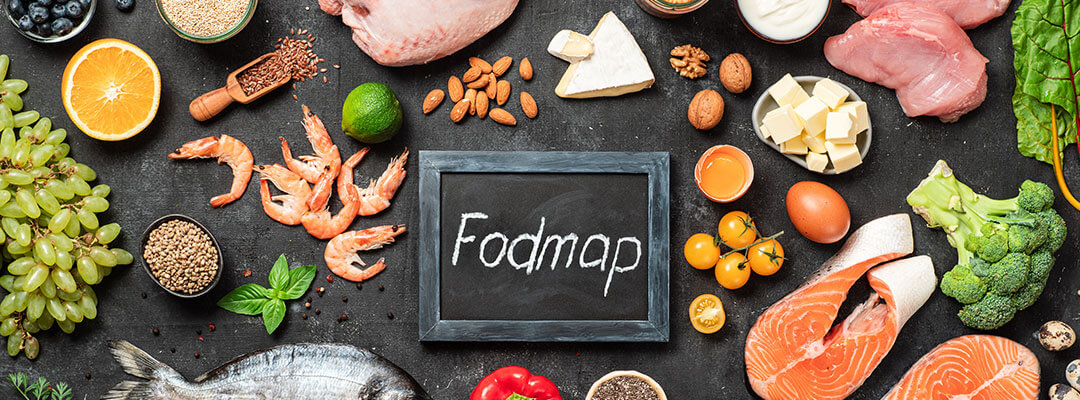There are a myriad of diets capturing headlines these days, but one rooted in science is low FODMAP paleo. At this point, paleo rolls off of most people’s tongues and the premise is generally understood, but low FODMAP paleo probably still raises some eyebrows as to what it entails.
Low FODMAP paleo is exactly as it sounds—a paleo diet coupled with a low FODMAP diet. Simple right? But what exactly does that mean and what can and can’t you eat if you want to follow it?
In this post we’ll cover everything you need to know about the low FODMAP paleo diet including:
- What exactly are FODMAPs?
- How do they play into a paleo diet?
- Why should you consider reducing your FODMAP intake?
- A comprehensive list of paleo foods that are safe, those that are potentially harmful and those that you should avoid when adhering to a low FODMAP diet.

What Are FODMAPs?
FODMAP is an acronym for Fermentable Oligosaccharides Disaccharides Monosaccharides and Polyols. They are a group of short-chain non-digestible carbohydrates (or sugars) that cause some people to experience gastrointestinal symptoms upon consumption. These sugars are typically found in vegetables, fruits, and grains. Because they are non-digestible, after consumption they may sit in your gut and ferment—hence the first letter of the acronym.
The remainder of the acronym consists of:
Oligosaccharides: grains, nuts, legumes, artichokes, garlic, and onion
Disaccharides: dairy products with lactose such as milk, yogurt, soft cheese, ice cream, buttermilk, condensed milk, and whipped cream
Monosaccharides: Fruits with fructose, including apples, pears, watermelon, and mango and sweeteners such as honey and agave nectar
Polyols: Mannitol and sorbitol. These can be found in apples, pears, cauliflower, stone fruits, mushrooms, and snow peas. They are also present in sugar alcohols such as xylitol.
Those who experience gastrointestinal symptoms from consuming FODMAPs may encounter diarrhea, constipation, bloating, gas, pain, and cramping. A low FODMAP diet is often recommended for IBS sufferers, and it’s important to remember irritable bowel syndrome is a cluster of digestive issues with several potential causes. Often, eliminating FODMAPs can help pinpoint the cause and alleviate symptoms.
What Is a Low Fodmap Paleo Diet?
Most paleo dieters choose this way of eating with the goal of getting back to basics and consuming real, whole foods while eliminating processed foods (and possibly as a weight loss diet). Those who follow a low FODMAP paleo diet are often seeking to address general digestive symptoms, food intolerances, irritable bowel syndrome, or other functional gastrointestinal disorders. A low FODMAP paleo diet offers all the benefits of a paleo diet with the added bonus of serving as an elimination diet to get to the root cause of digestive symptoms. If FODMAP sensitivity is a culprit, it’s evident pretty quickly once you remove, or drastically cut down on them.
The list of foods considered paleo is extensive, however, removing certain foods that are paleo AND high FODMAP does significantly narrow that list down. Not to fret, there are still a vast array of allowed foods and plenty of low FODMAP recipes to be found. You just need to know what to look out for [PDF]. A straightforward paleo diet does a pretty good job at eliminating a lot of FODMAP foods, with grains being a substantial chunk of that. Just a couple more tweaks can make a difference for your chronic gut symptoms.
Safe Paleo Foods With Low FODMAP Content
Vegetables and Fruits:
- Bamboo shoots
- Bok choy
- Bell peppers
- Carrots
- Cassava
- Chives
- Cucumbers
- Dandelion greens
- Eggplant
- Endive
- Fermented vegetables (raw sauerkraut, or lacto- fermented vegetables)
- Ginger
- Green beans
- Kale
- Lettuce
- Olives
- Parsnips
- Pattypan squash
- Sea vegetables
- Spinach
- Spring onions/scallions (green part only)
- Sprouts and microgreens (including alfalfa and sunflower)
- Zucchini
- Yellow squash
- Swiss chard
- Tomatoes
- Acorn squash
- Butternut
- Pumpkin
- Spaghetti squash
- Ripe banana
- Blueberries
- Grapefruit
- Kiwi
- Lemon
- Lime
- Mandarin
- Cantaloupe
- Honeydew
- Oranges
- Papaya
- Passionfruit
- Pickles (no sugar)
- Pineapple
- Plantains
- Raspberries
- Rhubarb
- Rutabaga
- Strawberries
- Swiss chard
- Taro
- Turnip
- Yuca
Protein:
- Muscle meats
- Organ meats
- Fish and Seafood
- Poultry
- Eggs
- Sugar-free bacon
Fats:
- Avocado oil
- Coconut oil
- Cod liver oil
- Butter
- Ghee
- Lard from pastured animals
- Extra-virgin olive oil
- Macadamia oil
- Homemade mayonnaise
Beverages:
- Water
- Homemade bone broth
- Tea (unsweetened white, green, oolong, rooibos)
- Herbal teas without FODMAP fruits
Other:
- Fresh and dried herbs
- Pepper
- Salt
- Seaweed
- Vinegars
Potentially Harmful Paleo Foods to Reduce
Vegetables and Fruits:
- Beets
- Brussels sprouts
- Broccoli
- Butternut squash
- Cauliflower
- Celery
- Fennel bulb
- Green peas
- Grapes
- Unripe banana
- Sweet potato
- Yam
- Garlic and onion powders
- Teas with fruits containing polyols or fructose
- Avocado
- Celery
- Mushrooms
- Longan
- Lychee
- Rambutan
- Sauerkraut
Other:
- Most nuts and nut butters are difficult to digest
High FODMAP Paleo Foods to Avoid
Vegetables and fruits:
- Artichoke
- Jerusalem artichoke
- Asparagus
- Broccoli
- Cabbage
- Garlic (including garlic salt and garlic powder)
- Leek
- Nectarine
- Okra
- Onion
- Peach
- Pear
- Persimmon
- Plum
- Shallots
- Snow peas
- Sugar snap peas
- Raddichio
- Tomato sauces and tomato paste
- Apple
- Cherries
- Mango
- Watermelon
- Dried fruit
Other:
- Pistachios
- Almonds
- Hazelnuts
- Agave syrup
- Chicory
- Honey
In addition to the above, following a low FODMAP paleo diet unsurprisingly means eliminating all of the standard non-paleo foods as well:
- Grains and gluten
- Legumes (lentils, beans, and peanuts)
- Soy
- Vegetable oils (canola, sunflower, safflower, grape seed, soybean, cottonseed and peanut oils)
- Commercially prepared sauces and dressings
- Cheese
- All commercial dairy products
- Artificial sweeteners
- High-fructose corn syrup
- Refined sugars
- Sugar alcohols
- Guar gum, carrageenan, soy lecithin
- MSG and food colorings
- Beer
- Fruit juice
- Soda
- High-sugar wine
Summary
If you’ve been adhering to a paleo diet for quite some time but still find yourself suffering from some belly woes, tacking on a low FODMAP approach may do a world of wonders. Sometimes even healthy, real, innocuous seeming foods may be contributing to a leaky gut and digestive disturbances.
Eliminating some of the common offenders for even just a short period of time can help drill down to the underlying issue and maximize your gut health.
While a low FODMAP paleo diet may seem restrictive, keep in mind it doesn’t necessarily mean it will be forever. Sticking to whole foods, reading labels, and remembering that most paleo recipes you may already be enjoying are easy to modify to fit the criteria of low FODMAP.
A myPrimalCoach is always at the ready to help you navigate a low FODMAP paleo diet, answer any question you may have, and offer a new set of eyes when connecting the dots of the food you consume and your symptoms.

